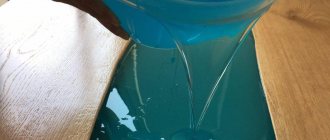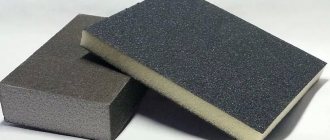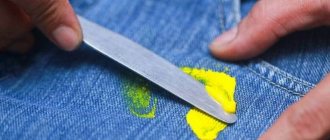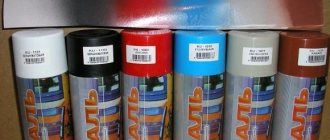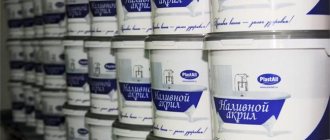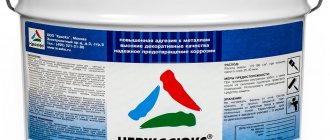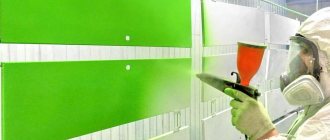Let's clarify right away: what kind of resin should be washed? Freshly diluted compound with hardener, a drop of which accidentally fell on a wooden table surface, bathroom tiles or clothes? Or did the sticky, viscous mass get on your hands or another part of the body?
Then nothing could be simpler: a swab moistened with acetone will quickly dissolve the epoxy, after which surfaces or clothes are washed with soap and other detergents, hands are also washed with soap, and then any cosmetic cream is rubbed into them.
Expert opinion
Oleg Vasiliev
Master of making furniture and interior items from epoxy resin. She creates unique items to order in her own production.
Ask a question to the master
Also suitable for dissolving liquid epoxy and ethyl alcohol.
But the picture will be completely different if the epoxy composition has already hardened. We have already repeatedly mentioned in other materials about epoxy resins about such a property of these materials as exceptional adhesion, that is, the ability to stick to all surfaces, no matter what they are made of, absorbing into the smallest pores and crevices. The only exceptions are silicone, Teflon and almost all types of polyethylene.
It is not surprising that with such stickiness, after 3-4 hours an unnoticed droplet that falls on a surface not intended for this freezes into a beautiful amber ball. It’s not needed at all in this place, and the same acetone needed for dissolution, even if it takes the frozen epoxy, it’s in such micron layers that this process will last for many hours. And material in which a drop of resin has frozen may react poorly to acetone or some other solvent, and then other cleaning methods will be needed. Let's look at some of them.
Compliance with safety regulations
Epoxy resin becomes harmless to humans only after the complete polymerization process. Until this point, it emits toxic fumes. Therefore, working with it requires compliance with safety precautions. It consists of the following:
- Respiratory protection. A respirator mask is used. It is better to use special masks with a built-in filter that can isolate organic matter.
- Leather. If the resinous substance comes into contact with the skin, a serious allergic reaction begins to develop. To minimize this risk, when working, use protective gloves (preferably latex-based to prevent the resin from sticking) and long-sleeved work clothes.
- Hair should also be removed and hidden under a cap. If a hair accidentally ends up in the mass, then after hardening the product will not look particularly attractive.
- The working surface of the table should also be protected. For this, polyethylene film is used. Epoxy resin cannot glue polyethylene, so it should be used to protect the desktop.
What not to do and why?
In an effort to quickly clean a stained surface from epoxy resin stains, it is important to avoid common mistakes:
- Exposure to sharp objects (knife, sharp side of a spatula, screwdriver) in order to chip off the resin deposit can damage any base.
- Hitting the resin to break it up can also ruin the stained base. Hammers and similar tools are prohibited.
- Solvents should not be used extensively - the effect should be local, affecting only the stained area. This is especially important in cases where they are used to remove contamination from the skin.
- Sulfuric acid should not be used as an epoxy solvent. This is a dangerous toxic drug that reacts with human skin, wood, metal and other materials.
How to make resin at home
Making epoxy resin yourself is a fun and interesting activity. But it requires certain knowledge, rules and compliance with all required safety precautions.
What is necessary
To prepare epoxy resin, you should provide everything necessary for work in advance. You will need the following materials:
- resin and included hardener;
- plastic measuring cups;
- disposable syringes for dosage accuracy;
- wooden sticks for kneading the finished mass.
Epoxy resin only works in combination with a hardener
Manufacturing instructions
To make your own epoxy, it is better to use the cold pour method. That is, mixing the resinous substance with the hardener is carried out at room temperature (not higher than +25⁰C).
The manufacturing recipe involves carefully adding a hardener-catalyst to the viscous mass. Without the participation of this ingredient, the polymerization process will not begin. The catalyst is added slowly, remember that when it is mixed with the resin, a thermal reaction begins. When adding the hardener, the mixture is constantly mixed with a wooden spatula.
How to make resin hardener
The catalyst is usually included with the resin substance, but is often missing during design work. Many home craftsmen are interested in whether there is a way to prepare the hardener on their own. It will not be possible to produce the necessary substance, similar in technical parameters to the hardener - this requires certain chemical elements and specialized equipment.
But you can replace the missing hardener with substances that are often included in your kitchen or home workshop. For example, using dry alcohol. To do this, an alcohol tablet is crushed and mixed into a resinous substance in a ratio of 1x10. After which the mass is left for 10–12 hours to acquire the desired viscosity. Then it can be used to fill molds. But the quality of the final product will not be perfect.
Final processing of the material
After the epoxy hardens and the finished product is obtained, it must be subjected to finishing. For this, polishing pastes and grinding machines are used. This processing gives the finished products ideal transparency and smooth shapes.
The frozen product needs to be processed
Epoxy glue on clothes - cleaning variations
Frozen clumps of resin on good clothes are an unpleasant phenomenon, but also completely removable.
Advice! Large pieces of dirt must first be mechanically scraped off with a knife or a thin file. This method is applicable only for rough work clothes: overalls, denim trousers, aprons.
Finer fabrics should be cleaned delicately and carefully. You can remove stains at home using well-known products.
For best results, glue stains must be frozen. We place the clothes in the freezer for two to three hours, the cleansing process will go faster and more efficiently.
- Alcohols. Wine, ammonia, and denatured alcohol are excellent means for resuscitating your favorite clothes. We moisten a piece of clean rag or a cotton-gauze swab in alcohol and begin to clean the dirty stains. As a rule, with some effort, it is quite possible to achieve complete victory over the dirt.
- Turpentine. Natural pine extract has a good cleansing effect. For fabrics, it is better to choose pharmaceutical gum turpentine rather than technical turpentine. Apply generously to the stain and leave it on the clothing material for a while. Take a soft brush and scrub the stain. Turpentine has a sharp, characteristic odor, which can be eliminated by subsequent washing in the machine with aromatic powder and conditioner. For stubborn stains, use a solution of turpentine and alcohol mixed in equal parts.
- Melting. Epoxy can both harden and liquefy. For this purpose, a heating method is used. For fabric, ironing stains with a hot iron works well. Lay the material out on an ironing board and place a piece of clean plain fabric or a paper towel on both sides under the stains. With intensive ironing, the glue will gradually melt and be absorbed into the substrate. After the procedure, light stains should also be rubbed with alcohol to consolidate the effect. The final stage of cleaning will be automatic washing of clothes on a standard cycle.
- Store-bought stain removers. Some types of stain removers are very successful at removing even stubborn stains such as epoxy glue. Stains from white clothing should be washed with oxygen-containing bleaches. Soak a white item in warm water, add bleach and leave for 1-2 hours to act. Yellowish stains on the fabric after soaking will disappear when washed in an automatic machine.
- Solvents. Silk and synthetic fabrics lend themselves well to cleaning with a range of solvents. Printed fabrics can be cleaned with nail polish remover; it is less aggressive to fibers and patterns. For difficult to remove stains from plain clothes, white spirit or acetone are more suitable.
Non-standard methods for cleaning clothes
As practice shows, non-trivial ways to save wardrobe items dear to your heart also work.
For example, the well-known brands of carbonated drinks “Coca-Cola” and “Pepsi-Cola” have proven themselves well as a powerful household cleaner.
Of course, there is no need to add lemonade to the washing machine, but it is quite possible to mechanically remove stains from colored fabrics. After the obvious cleaning effect, it is better to wash the item thoroughly.
Dimexide is a cheap pharmaceutical product for treating postoperative sutures and compresses. Dimexide should be diluted in warm water in approximately a ratio of 1:3, wet the fabric generously with the solution, leave for a while, and then wash in the usual way.
Washing from clothes
After the composition gets on the fabric, the stains are absorbed very quickly and harden no less quickly. Aggressive techniques can destroy the fibers, so cleaning will lead to irreparable damage to the item. But you can try to clean small resin stains in this way:
- Ammonia solution 10% or ethyl alcohol. You should moisten the stain, and after a couple of minutes, clean it with the corner of a spatula.
- Freezing. Place the bag with the item in the freezer for a couple of hours, then scrape off the epoxy.
- Heating. Place white paper on the epoxy stain and iron it until the compound melts. Remove it with any suitable device.
There are also more exotic methods for removing stains. Thus, the resin can be dissolved by the action of Pepsi or Coca-Cola soda, after which it can be removed from the fabric. You can also lubricate the drips with the pharmaceutical preparation “Dimexide”. Mix it with water 1:3, wet the item, and remove the stain. After using any method, you need to wash the product in a machine with regular washing powder.
Temperature methods of influence
Epoxy resin is designed to be used in a limited temperature range. Excessive heating can cause the resin to become viscous, while freezing, on the contrary, makes the epoxy brittle. These physical properties make it possible to use temperature effects for removal - heating and freezing.
Heat
Using heat is one of the gentle methods.
You can even use an ordinary hair dryer, but a construction hair dryer is better. In order to get a good result, you need to set the device to a high temperature.
The heating process should take place evenly - to do this, the hair dryer is moved from side to side over the affected area. After the top layer of the stain has warmed up, it is carefully removed with a spatula.
For epoxy that has hardened in a thick layer, heating and using a spatula must be repeated several times. This will allow you to remove the entire composition carefully, without damaging the base. Gradual stripping is a necessary condition, since the entire voluminous layer is not able to warm up at once.
The heating method can only be used on heat-resistant surfaces.
Freezing
To remove epoxy from a surface, it can be frozen. For small items, such as clothing, it is permissible to place the item in the refrigerator.
After exposure to low temperatures, the resin crumbles easily - it can be broken into pieces and shaken off; from dense materials - cleaned off with a spatula.
In cases where it is impossible to place an item in the refrigerator, a special aerosol is used that cools the desired area when sprayed. As a result, the hardened resin becomes cracked and can be removed.
The use of aerosol freezing agents must be carried out strictly in accordance with the instructions for the specific drug.
How to clean from different surfaces?
The resinous composition can be removed from various surfaces in various ways. It is necessary to take into account the type of material - this will avoid damage.
Some of the highest demands are placed on removing dirt from the skin, since using inappropriate methods can cause irritation and even wounds. It is easiest to clean stains from a hard surface that is resistant to temperature and the use of solvents.
From hand
Removing epoxy from leather is a responsible undertaking. It is advisable to remove the composition immediately when it first gets on the skin.
It is better to use tar or laundry soap. Residual resin can be washed off with acetone or denatured alcohol. If this does not work, you will have to use one of the home recipes or a purchased solvent.
It should be borne in mind that even seemingly safe compositions can cause irritation and dryness of the skin. After using any of the products, you must thoroughly rinse off the composition and lubricate the skin of your hands with a softening cream.
The best products for removing epoxy, including from a child’s skin:
- use of vegetable oil;
- applying thick cream, etc.
The greasy composition is generously applied to the stained area and rubbed in. The resin will begin to come off very quickly. Using a washcloth or soft brush will help speed up the process.
Methods such as heating are not recommended for treating the skin . It may cause burns. You can apply ice cubes to the stained area - this will help scrape off the resin easier. But this option requires very careful use so as not to cause frostbite.
If simple recipes do not help, solvents can be used to a limited extent. To do this, soak a tampon with the product and carefully treat the area.
From plastic
Plastic is one of the most difficult surfaces to remove resin from. The use of solvents may be limited, and only in those situations where this is permitted according to the instructions for the drug.
Heating can damage the plastic surface , leading to its deformation and loss of its original characteristics.
For some types, exposure to ice is suitable, but for thin, delicate surfaces that are not designed for temperature changes, a method using fats - cream, oil - is suitable.
From fabric
Removing resin from fabric can be very difficult. The porous material easily absorbs the substance, as a result of which the stain becomes persistent and difficult to remove.
For processing it is possible to use:
- pharmaceutical alcohol;
- turpentine with ammonia and starch;
- heating from the inside out, etc.
When using any product, it is necessary to take into account the type of fabric from which the clothing is made.
From glass and tiles
Smooth glass and tile surfaces are easy to clean in cases where the resin has not yet set. To do this, simply wipe the stain with a damp sponge.
If the composition has time to set, then heating and freezing methods are suitable . They will both be effective.
Heating should be done with caution to avoid sudden temperature changes. The softened plastic resinous composition can be cleaned off and the area wiped with a damp cloth.
Freezing is conveniently carried out using an aerosol can . After the surface begins to crack, the composition is cleaned off.
Chemical reagents - solvents, are also suitable for use. After the resin has dissolved, it is removed and the surface is washed using cleaning agents.
What is epoxy resin
Epoxy resin in its pure form is an oligomer consisting of short chains of molecules. To transform it into a polymer, various hardeners are used, resulting in a glassy substance.
Epoxy that gets on the epidermis can cause pathological reactions:
- allergies (atopic dermatitis, urticaria);
- burns on the skin and mucous membranes;
- intoxication of the body.
When epoxy is mixed with a solvent, a plastic substance with various properties is obtained. It can be soft, easily deformed, or hard as metal. When choosing a method for removing such stains, their size and the type of material that has been contaminated (wood, metal, human skin) are of particular importance.
Where are resin contaminations most often located?
The most common way to use epoxy resin is as an adhesive. Epoxy glue is an old proven tool for repairing rubber products, shoes, gluing wooden and ceramic surfaces.
In domestic conditions, glue most often gets on unprotected areas of the skin of the hands, as well as on items of clothing. Therefore, it is strongly recommended to work with glue wearing protective gloves and an apron.
If the substance does get on the skin, it is necessary to take immediate action, since synthetic resin is an aggressive chemical and can cause burns to the epidermis, dermatitis, and allergic reactions.
Epoxy resin painting process
By attending a master class on using epoxy resin for creativity, you can learn how to create real masterpieces. Preparation consists of selecting the necessary equipment:
Film to protect the working surface. Masking tape. It is needed to cover those elements of the future drawing that the epoxy should not get on. Scissors. Building level
Before starting work, it is important to check that the surface is smooth and horizontal. Gloves to protect your hands, an apron and goggles. Cups or other container for mixing colors. Wooden sticks. Additional means - sticks, toothpicks, straws. Sometimes you may need a hair dryer. Acetone or other solvent
With its help, resin that has not yet hardened is removed. A gas torch is used to heat the resin to remove air bubbles from it. Primer. It is applied to the base (wood, plywood) to prevent absorption of the material.
Having prepared everything you need, you can start drawing. The process consists of the following stages:
- Prepare the surface. Place a tablet stand on it. You can use disposable cups instead. Place the tablet on top, sealing it around the perimeter with masking tape.
- Prime the base.
- Paint over the resin by adding a few drops of suitable paint. Pour the mixture onto the base, forming a pattern with a stick or your finger.
There are other drawing techniques in which the main material is epoxy resin; master classes will help you master them.
Silicate glue to replace epoxy
How can I reliably glue parts together if epoxy glue is not available? In household repairs of shoes, appliances, electronics, and furniture, epoxy is most often used. But as a replacement, you can purchase silicate glue - it is great for fabric, wood, plastic, glass, ceramics, and metal. Like epoxy, materials are impregnated with this glue to ensure fire resistance.
To enhance the strength of the product and bring its performance closer to epoxy, you can independently prepare different types of glue:
- Mix 100 ml of silicate glue, 32 g of powdered glass, 50 g of asbestos. This composition has high thermal and chemical resistance.
- Take a small amount of glue, add quartz sand and asbestos to it until it reaches a thick consistency. This material will be resistant to alkalis and acids.
- 16 g of glue is combined with 40 g of milk casein, the composition has increased moisture resistance.
If you plan to use epoxy to seal a bathroom or kitchen sink, you can buy regular silicone sealant. It is inexpensive, and its properties are no worse than epoxy resin.
How to clean epoxy resin
How to remove epoxy resin from table surfaces and dishes? Solvent 646 removes epoxy from surfaces; it is used to wash dishes used in work and molds for pouring. Acetone can also be used to clean work surfaces after work.
The following product has existed in the arsenal of household and finishing chemicals since Soviet times, and in some places continues to be produced: Universal remover for old paints and varnishes.
The wash also softens the dried coating, which can then be removed from the surface with a spatula or knife. It can be used to wash work surfaces and tools, but it cannot be used as a solvent. Craftsmen hold brushes, rollers in the above-mentioned solvents and washes; they wash spray guns and molds.
How to remove with special compounds?
Ready-made solvents can be used to remove epoxy resin from various surfaces. These are chemicals that require storage only in appropriate conditions and careful use.
Solvent 646
The solvent has a wide range of applications . It can be used not only to remove stains, but also to clean molds that were used to pour the epoxy compound, as well as used tools.
Half of the composition is toluene. It also contains butyl alcohol, acetone and other components. The solvent is used in its pure form, applied with a napkin or sponge. After the epoxy softens, everything is cleaned off and the surface is washed.
The products are produced in packaging of various sizes . 1 liter costs about 100 rubles, 10 liters - from 800 rubles.
Cleaner SP-6
Remover is a synthetic chemical substance that softens epoxy resin. Having become plastic, it can be easily removed with a regular spatula.
The remover has proven itself well when it is necessary to remove resin from metal surfaces. To do this, the solvent must be applied to the stain for half an hour , and then begin removal.
The price of the wash is about 700 rubles for a container of 0.8 kg.
DOCKER EPOXY (G)
Professional epoxy remover is available in containers weighing 13 kg and 5 kg . It is a gel mass. DOCKER EPOXY is capable of removing almost all types of epoxy mixtures. Contains no acids.
The composition is applied with a brush or any other method. After leaving the epoxy on the surface for 10-20 minutes, the composition is cleaned off with a spatula.
If the surface of the epoxy composition is multi-layered, then processing can be continued. Restriction - the remover should not remain on the material for more than 2 hours.
The price of a package weighing 1 kg is about 1,400 rubles.
How to remove epoxy resin - 4 best ways
The enterprises produce epoxy adhesive with a hardener. Individual manufacturers have different compositions. Some brands after long-term storage thicken and acquire excessive viscosity. It is necessary to wash brushes, spray guns, and dishes after use.
Even masters do not always know what can be used to dissolve epoxy resin; they determine the solvent by trial and error.
Important: glue based on this oligomer is removed immediately before it has time to harden. A hardened mass (especially with a hardener) acquires strength, hardness, and it becomes more difficult to get rid of it
This is why acetone is the best resin solvent. Easily binding to the phenols of the molecule, it softens and dissolves the epoxy.
The picture shows the molecular unit of bisphenol A, which was discovered by Russian scientist A.P. Dionin in 1891. The word "epoxide" is formed from two Greek words: epi - above and oxy - sour.
Solvent 646, used to dissolve nitro enamels and nitro varnishes, softens the hardened base. As a solvent, it works worse, forming whitish flakes in the mass.
Xylene (dimethylbenzene) does not react with glue. Denatured alcohol will be weak and helpless.
Restoration of things and objects requires separation of glued parts
Therefore, it is important for the master to know how to dissolve epoxy glue without compromising the integrity of the structures, so that upon completion of the restoration work the parts can be reconnected
One option for breaking adhesive bonds is to heat the part. If the part is not plastic, it can be heated with a hair dryer. As the temperature rises, most adhesive masses soften, melt, and no longer hold the glued surfaces.
Heating cleans dirt from spilled varnish, glue on a table, floor, or other surface.
The thin film is cleaned from the surface by scraping and carefully removed layer by layer. In this way, the carpenter removes old varnish coatings before restoration.
Scraping is carried out with sandpaper, scrapers and even glass. Experienced craftsmen work with glass.
And finally, the last method used to remove spilled glue or varnish is to expose it to a refrigerant.
The product is sold at a hardware or hardware store. Under the influence of the cooling agent, the temperature in the epoxy drops, as a result of which the molecular bonds inside the mass are destroyed. It becomes fragile, crumbles easily, and crumbles. You can clean it from the surface with a knife or spatula.
Thus, there are 4 ways to remove epoxy from the surface:
Dissolution with solvent 646, acetone or remover; Heating to soften it, after which the soft substance is removed with a metal tool; Carefully scrape off the epoxy stain with a sharp tool; Treatment with a refrigerant to cure the epoxy to a brittle state.
A story about how epoxy varnish saved a master’s reputation
This happened in the distant nineties, when the collapse of the Union led to the severance of economic ties, the shutdown of enterprises and the ensuing delights of devastation. People left without work and wages were forced to adapt. My husband Yuri was a good specialist in the field of furniture restoration.
One day he received an order to varnish and renew a wall. Without hesitation, he chose NC varnish for the job, considering it the best. The advantage was fast drying, within an hour, a strong, durable film. True, the varnish really let him down.
We lived in Azerbaijan, in a city where there is almost no winter. That is, frosts and snow are rare here. Economic devastation led to gas and heating being cut off.
The order was carried out in winter. Outside the window the temperature was around zero, in a large private house - +5 +7 oC. Nitrocellulose varnish began to act up at this temperature. It took a little longer to dry, and as it dried it attracted moisture, and the film became covered with a white coating. Yuri was confused.
We tried to install an electric stove, but it did not warm up the spacious room. The lack of gas forced the entire population of the city to switch to electricity; the voltage in the network was extremely low. We tried pentaphthalic varnish, but on fresh nitrocellulose the PF stood up like a fur coat and flaked.
In the fall we bought inexpensive epoxy varnish. The half-liter bottle was accompanied by a fifty-gram bottle of hardener. We decided to try it.
The varnish flowed well, lay on top of the nitrocellulose film, and most importantly, it suppressed the white coating. The coverage turned out good. The master did not have any questions about how to dissolve or how to wash off the epoxy resin. The varnish did not require solvent. Drying took a day. But a way out was found.
Read more ► How to dissolve silicone: effective ways to remove sealant from various surfaces
The brushes were kept in varnish without hardener. Fresh drops and smudges were wiped off with acetone purchased to dilute NC.
Stain Cleaning Options
If there is a stain left from epoxy glue after use, you will have to use removal methods, because removing epoxy glue with a wet rag will not work. It is customary to distinguish between gentle and aggressive cleaning methods:
- heat;
- freezing;
- mechanical cleaning;
- use of chemical solvents.
When the base is heated
If epoxy glue was used at home and stains remain after working with it, you can try to remove them with a household hair dryer. It is permissible to remove the adhesive composition this way if the surface is heat-resistant and can withstand a hot air flow. Everything must be done in the following sequence:
- The temperature of the hair dryer is set to the maximum level.
- A hot air stream is directed onto the surface to be cleaned.
- The hairdryer should be moved in different directions to ensure maximum uniform heating.
- Gradually the glue will soften, so it is necessary to systematically remove the adhesive composition layer by layer using a spatula.
If you are cleaning a wooden surface, it is recommended to first moisten it with acetone to prevent cracking.
Method for freezing contamination
To use this method, you need to go to a hardware store and buy refrigerant in the form of an aerosol.
You also need to use personal protective equipment: goggles, respirator. Before use, you must read the instructions. Typically, freezing the surface to remove glue is done as follows:
- First you need to shake the aerosol can.
- Then you need to spray the refrigerant evenly onto the hardened adhesive composition.
- If the freezing is good, the epoxy glue will become brittle and cracks will appear on it.
- If this happens, the frozen composition just needs to be pryed off with a spatula and removed from the material.
The procedure can be repeated several times until all the frozen composition is removed. Due to freezing of the glue and when breaking the frozen composition, sharp fragments will form, so you need to be especially careful.
Mechanical cleaning
If a stain of epoxy glue has frozen on a metal or other surface that is resistant to mechanical stress, you can try to scrape off the resin with a sharp spatula or other suitable means. This is an aggressive cleaning method that will not work for most materials.
It should be used as a last resort when there is no time to heat the surface, freeze it or use solvents. Even durable metal surfaces can deteriorate over time due to strong mechanical stress, because... Corrosion processes will occur in places where scratches occur.
Using chemical solvents
An aggressive method, when used, there is a high probability of damage to the material and surface (especially if it is varnished or painted). Chemical solvents are suitable in cases where other methods have failed.
As a composition for cleaning the surface of epoxy glue, you can use:
- household nail polish remover;
- acetone;
- ethyl acetate;
- toluene;
- butyl acetate
You need to moisten the resin stain with the solvent as evenly as possible, then wait a little and try to remove the stain with a spatula. When using the method of dissolving the resin, it is possible to remove the epoxy almost always, because acetone and its analogues are capable of dissolving epoxy glue completely.
Useful tips
It happens that during the cleaning process a little epoxy glue gets on the skin (hands, other areas). This mainly happens to those who neglect the recommendations on the use of protective gloves. If you do not react promptly, there is a high risk of getting a chemical burn or developing contact dermatitis. The following manipulations are necessary:
- immediately wash the area where the epoxy came in contact with soap and water;
- apply any disinfectant to this area;
- Dry the treated area thoroughly with a soft cloth or paper towel.
Clean with hands
You can use acetone to remove epoxy glue stains from your hands, but this should not be done if you have sensitive skin. Acetone (nail polish remover) treats only the area where the resin has entered, and not the entire hand. Otherwise, cracks may appear on the surface of the skin. After cleaning with acetone, wash your hands with soap and apply any nourishing cream to the skin.
Wash off clothes
The epoxy is absorbed into the fabric instantly and hardens very quickly. Aggressive cleaning methods can destroy the fibers, and the item will be irreversibly damaged. You can try to clean small resin stains.
- Moisten the stain with 10% ammonia and ethyl alcohol. Wait a couple of minutes, then scrape off the resin with the corner of a spatula.
- Place the soiled item in a tight bag and freeze for 2 hours. Then try to scrape the epoxy off the material.
- Cover the tar stain with a clean sheet of paper and run a heated iron over it several times until the composition is completely melted. Then remove the resin using any suitable device.
Remove resin from tiles
Unsightly epoxy deposits are easy to remove if the stains are fresh. You will need a damp cloth and soap solution. To combat frozen stains, any method described above is suitable: heating, freezing, chemical solvents. The tile is resistant to almost any method of exposure. But the only way to remove glue from the board is with a soldering iron. Other options will damage the part without a chance of recovery.
To learn how to dissolve epoxy resin, see the following video.
Features of diluting epoxy resin
Epoxy resin, being an integral part of epoxy glue, has a viscous consistency; this characteristic sometimes interferes with its comfortable use. You can dilute the epoxy by heating it or adding a solvent to it.
Adding solvent is an easy and quick method to reduce the viscosity of the resin, but at the same time the strength and water resistance are reduced. Almost all solvents are used to dilute this material, but preference is given to volatile ones, since they quickly turn into a gaseous state without remaining in the mass.
When diluting the composition, it is important to consider the following features:
- Even a small volume of solvent helps to significantly reduce the viscosity of the resin;
- The addition of a solvent helps to reduce the hardness of the resulting polymer, which prevents its use for the manufacture of structural products;
- The solvent increases the tack and hardening time;
- The introduction of a solvent into the material subsequently causes it to shrink;
- That part of the solvent that has not evaporated can cause microcracks;
- Substances used for dilution may change the color of the polymer;
- The presence of substances introduced into the epoxy can harm the surface;
- The increased fluidity of the resin interferes with working with it on verticals.
Adding solvent is an easy and quick method to reduce the viscosity of the resin, but at the same time the strength and water resistance are reduced.
Thermal dilution method is the most preferred. With this method, there is no reduction in the strength of the polymer, and it will also make working with the unhardened mass easier. The resin is heated without adding a hardener; it is added at the end. This avoids excessive overheating of the mass.
Thermal dilution method is the most preferred.
Recommendations
Expert advice will help you cope with the task of removing epoxy resin as simply and without consequences as possible:
All work with solvents should be carried out with rubber gloves, with good ventilation. Expired solvents may be ineffective. Any use of chemical solvents must take into account how the substance used may affect the material that is stained
To avoid troubles, it is important to study the instructions for the product you are purchasing in advance. Recipes and tips for removing resin from various surfaces are presented in this section
Recipes and tips for removing resin from various surfaces are presented in this section.
Removal Features
Epoxy resin is a structurally complex multicomponent substance that has a complex composition. It is its composition that makes it difficult to remove .
In its pure form it is an oligomer. In order for the resin to harden, a hardener is used. The result is a solid polymer with a synthetic base that adheres well to the surface.
Tree resin is different. Coniferous resins contain only natural substances, while synthetic ones contain:
- silica,
- structure seals,
- fiberglass, etc.
Solvents (homemade and purchased) that can soften the hardened polymer can help remove such a composition.
After contact with skin
If glue gets on the skin, aggressive cleaning methods should not be used so as not to aggravate the situation. If the gloves are torn during work and resin that has not yet hardened gets on the skin, you must:
- Remove damaged gloves.
- Wash your hands quickly with running water and soap.
- Try to remove as much liquid resin from the skin as possible.
- Wash off the remaining substances using solvents, moistening a piece of cotton wool or a cotton pad in acetone or nail polish remover and wiping the contaminated areas.
- Wash your hands again with running water and soap.
- Wipe your palms dry.
- Lubricate the skin with a nourishing cream, as after exposure to solvents it may begin to dry and peel. Cured epoxy can be removed using oils. Sunflower or olive oil must be rubbed into the skin over and around the stain for some time, after which the epoxy will soften, begin to peel off from the surface of the skin, and it will be much easier to remove.
We invite you to familiarize yourself with Boiled Cherries
There are several methods for removing epoxy resin from the surfaces of objects, which can be divided into gentle and aggressive.
How to wipe off with folk remedies?
You can erase resin stains not only with solvents, but also with home remedies that you can find on the farm. The choice of method should take into account the type of base material. Traditional recipes may not be effective enough if large areas need to be cleaned.
Dimexide
An organic agent, dimethyl sulfoxide, can be used as a dissolution preparation.
It is a liquid that has no distinct odor or color. One of the frequently used options is pharmaceutical Dimexide .
The product is easily diluted with water. To use as a solvent, the composition is diluted 1:3 and applied to the surface. Once the resin has softened, it can be removed.
Alcohol
Medical alcohol can be used as a resin solvent. A sponge or napkin is soaked with undiluted preparation and applied to the stain for 15-20 minutes. The composition that has become viscous can be wiped off with the same cotton swab.
Oil
Vegetable oil has a mild effect. This allows it to be used to remove tar from the skin, including in children.
To remove the sponge, soak it in oil and rub it into the stain . You can even leave the cotton pad on the stain for a better effect for 10-15 minutes. After such exposure, the viscous composition is easier to remove.
The use of oil, like other fatty compounds, is not recommended when removing epoxy from fabrics.
Lemon acid
Regular citric acid will help deal with spilled epoxy and smudges.
For processing you will need:
- container with water;
- lemon acid;
- sponge.
The stain should be treated section by section. The sponge needs to be moistened and the excess water squeezed out. After this, it is dipped in acid powder and tinder.
It takes a very long time to process a large area in this way. But this method is good in cases where it is necessary to clean the skin of your hands .
How to remove with acetone?
Acetone can be used as a solvent. As an option, use a nail polish remover containing acetone.
Procedure:
- Moisten the sponge in the composition.
- Apply to the stain.
- Leave for 15-20 minutes.
- Try to erase.
For large stains, the acetone method may not be effective.
Denatured alcohol
Denatured alcohol is a solvent with a distinct unpleasant odor , which is widely used in industry. It can also be used to soften resin.
Use as a solvent - undiluted, until the resin becomes soft.
What to do if one of the components runs out?
As a rule, of the two components, the hardener usually runs out faster. The reason for this may be either failure to comply with the proportions prescribed in the instructions when mixing, or partial evaporation of the volatile liquid from a loosely closed bottle. The best solution in this case is to purchase the missing component of the same brand.
This is justified by the fact that most of the chemicals that some craftsmen use to replace the hardener do not give the desired result or make the gluing defective and require rework. Sometimes replacement is resorted to for cost reasons, but most types of epoxy adhesive are inexpensive, so replacing components will not provide significant savings.
Substitute options:
- phosphoric or sulfuric acid;
- benzoyl peroxide;
- polyethylene polyamine;
- ammonia.
These substances are either difficult to find on the open market, or you still have to go to the store for them (the exception is ammonia, which may already be in your home medicine cabinet). Therefore, instead of them, it is better to immediately buy a normal hardener, especially since it is sold not only complete with the resin, but also separately from it. For example, a 100 ml bottle of TETA (triethylenetetramine) hardener costs from 250 rubles. Purchasing a special hardening liquid will help complete the gluing process efficiently and avoid unpleasant surprises.
In some cases, a slightly larger volume of glue is required than is available. You can get out of this situation by adding some kind of filler to the adhesive (chalk powder, aluminum, asbestos, graphite or mica dust).
Heating
Epoxy stains can be successfully removed from tiles or kitchen furniture using heat. Initially, before contact with the hardener, the substance has the consistency of a gel. High temperature will return the resin to its previous gel-like aggregate state.
How to apply the method:
- Wear safety glasses and gloves. This is necessary because when heated, the epoxy resin releases vapors that are dangerous to the eyes and skin. Glasses should fit snugly to the face, have no holes, and provide good protection from the penetration of vapors into the eyes. Gloves should fit snugly to limit air ingress and cover the wrists by at least 8 cm.
- Wear long sleeves made of thick fabric. This will prevent harmful vapors from penetrating the skin.
- Lubricate the contaminated wooden surface with acetone. It will take at least 60 minutes for the resin to soften and absorb the product into it. After this, start heating.
- Turn on the hair dryer at maximum power and blow on the contaminated area for 3-5 minutes. The epoxy must heat up to 90° C, in which case it will soften.
Do not direct the hot stream of air motionlessly to one place; move the hairdryer from side to side while heating.
Be careful not to overheat the surface made of plastic or wood, as there is a risk of fire in these materials.
A hairdryer can be replaced by a blowtorch: run it along the edges of the contaminated area. As a result, the epoxy will soften.
Place a small object that has received resin on an electric stove. This way the area of contamination can be heated and the epoxy will become soft.
Use a hairdryer to heat small areas up to 8 cm in area; it is impossible to keep a large spot hot for a long time. When you completely separate one heated area from the surface, move on to the one next to it. Gradually you will be able to get rid of all the pollution.
Remove the epoxy adhesive (resin) using a razor blade, knife, or other sharp tool. In some cases, the contamination does not warm up completely, then continue to heat it.
Cleaning tiles and glass
There are different ways to remove resin from tile and glass surfaces. If the stains are fresh, they are removed by wiping with a damp sponge and soapy water. The hardened substance is removed by heating and cooling.
Heating
Contaminated areas are heated with a hair dryer until the resin softens. Then it is carefully cleaned with a convenient tool and wiped with a dry cloth.
Cooling
The resin is effectively cleaned by freezing it with a refrigerant. You should spray the spray on contaminated areas. The cracked substance is then removed with a sharp instrument.
See also
TOP 4 methods of how and with what you can clean a coat at home
How to dilute epoxy
Diluting the glue must be done carefully, so it is important to prepare protective equipment and working tools in advance. Rubber gloves and a protective mask are necessary to prevent damage to the skin and respiratory system, because both ingredients are quite toxic
It is also important to prepare mixing containers and sticks. It is important to ensure ventilation of the work area.
Diluting the glue must be done carefully, so it is important to prepare protective equipment and working tools in advance.
Ratio norms
In order to properly dilute epoxy glue, the proportions must be strictly observed. Typically, purchased chemicals come with instructions. It specifies mixing rules and proportions. To mix the composition, it is usually necessary to maintain a ratio of 10 to 1. That is, for 10 parts of the resin volume, take 1 part of the hardener.
Previously, for convenience, manufacturers produced formulations in containers with divisions. Today, you can use various available means for this.
In order to properly dilute epoxy glue, the proportions must be strictly observed.
Adding color
The epoxy resin is given color before it hardens.
It is important to know the physical and chemical properties of the dye and the mass itself to obtain the desired result. It is important to choose non-aqueous based materials when painting epoxy.
For successful coloring of the mass, it is important to follow the following recommendations:
When using oil paint, it is important that the mass of the dye does not exceed a tenth of the total volume; Do not allow moisture to get into the mixture; Ventilate the room well; It is necessary to work with resin at a temperature not lower than 22 degrees.
The color is added to the epoxy resin before it hardens.
It is better to use special pigments for coloring epoxy. They are presented in a wide range in construction stores. There are several types:
- Plain. Can be from white to black, as well as bright shades;
- Fluorescent. The composition includes a phosphor. This ensures the product glows in the dark;
- Matte. The presence of a special substance in the composition ensures a matte surface.
You can also use improvised means for coloring.
But it is important to consider that they can interact with each other. Also, this is not always advisable due to the low cost of piments
The following options can be used:
- Ink from ballpoint pens;
- Nitro dyes;
- Pencil leads;
- Printer toners;
- Dry pigments;
- Artistic oil paints;
- Alkyd dyes.
It is better to use special pigments for coloring epoxy.
How to mix at home
Before diluting epoxy resin, you need to read the instructions and study all the nuances. At home, you can only mix small volumes of resin. This can be done in a cool room. When working with large volumes at home, the composition immediately begins to harden due to the heat generated.
First, mix small volumes, and only then move on to larger ones. This is necessary in order to ensure that the proportions are selected correctly.
Substances are dosed using different syringes. Their size is selected taking into account the working volumes. Both components are poured into the prepared container and mixed thoroughly. There should be no air bubbles in the resulting mass. The finished mass should be transparent and uniform. After receiving the composition, you can add dyes and perform all the necessary work.
At home, you can only mix small volumes of resin.
